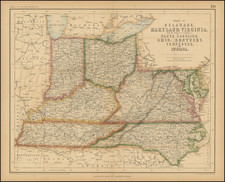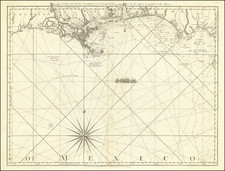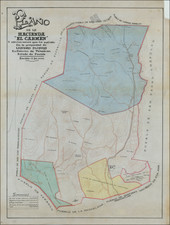A Colonial American Rarity - One of the Earliest English Maps of the Region
Rare early sea chart of the British and Spanish Colonies in North America, first published by John Seller in 1673.
Along with Morden & Berry's English Plantations in America, this is the first English map to focus on this region. Issued a year before the 1674 Treaty of Westminster ended the Dutch colonial presence in North America, the map's publication follows the Duke of York's being granted the control of the English Colonies north of the Delaware River (1664) and shortly before Charles II's grant to the Penn family of the lands which would become Pennsylvania in 1681, at a time when British interest and speculation in the region was about to explode.
Much of Seller's information was taken from a 1654 Spanish chart by Sebastian de Ruestra (Carta nautica del mar, costas islas de la Indias Occidentales . . . ), which no longer exists, but survives to day in a Dutch copy from circa 1670, which currently resides in the British Library and was likely in British hands at the time Seller's map was engraved. As noted in Jackson, "[Sebastian de] Ruesta was a cosmographer and maker of mathematical instruements in the Casa de Contratacion; his brother Francisco was Pilot Major," giving Sebastian access to the best available maps in the Spanish archives and access to returning explorers. "Thus it is safe to say that his original "Carta nautica" drew upon the Casa's existing state of knowledge, although it is not known what sources he tapped." Jackson further opines that Ruesta likely drew on a second manuscript map "en cuarterones," a manuscript map which also resides in the British Library.
Seller also incorporated details in the Carolinas from John Lederer's 1672 map, while the lower half of the chart has been completed from other sources.This is one of the earliest to show the influence of the Lederer lake, desert and nomenclature in the Carolina region.
Among the more fascinating elements of the map is the use of the name "Watkins Point," which dominates the Del-Mar-Va peninsula. This was the name given by John Smith to a small point on the Peninsula opposite the mouth of the Potomac River on his map of 1612 and later used in the charter setting the boundary between Maryland and Virginia in 1632.
In describing the map, Burden notes:
The composition of this map was probably influenced by the Robert Morden and and William Berry English Plantations in America, 1673. Closer examination reveals that the nomenclature derives from other sources. The region of the south-east names Ashley Lake, which illustrate that Seller utilises the latest knowledge from John Ogilby's map A New Discription of Carolina, c. 1673, for his Lederer cartography.
Normally, a second state of Seller's map was instigated by the formation of the combine with four otehr partners in 1677. However, in this case he altered the Gulf coastline of North America and added a large number of new place toponyms. The origin for these is unclear and may havebeen a manuscript [source]. At the same time he re-engraved the sloppy title. As this state is much rarer, it is believed to have occured only just prior to the formation of the combine which created the third state. . . .
This is the third state of the map, as noted above by Burden. The additional place names added on the Gulf Coast and Florida include:
- Rio Diserta (Texas Coast)
- Rio de la Magdalena (Texas Coast)
- C de Montanas (looks like a spanish copy of the more Portuguese place name to its right -- C. de Montanha)
- R. de Spirito Sancto (Misissippi River)
- Osial (Mississippi Delta)
- Qialata (Louisiana)
- Muslas de Salvador
- Marpequeno
- Re de Canveral (replaces R. Canavara)
- R Nieves is mored several rivers to the east and renamed R. Nives.
- C. Honda
- R. de Flores
- R. de Angelos (probably a correction of Rangeles
- R Gomes moved to the east and renamed R. Gomesorto
- Arenas Blancas (West Florida)
- Bay Miraculo (West Florida)
- B. Carolos (south of Tampa)
- B. de Joan Ponte (south Florida)
Other updates in Caribbean Islands:
- S. Gemane added (Puerto Rico)
- Pta de Aguada added (Puertor Rico)
- St. John changed to S. Iuan de Porto Rico
- More than a dozen new place names in Hispaniola
- Guanaguerico added (Cuba)
- Cabo Corrientes added (Cuba)
- Islos de Pinos added (Cuba)
- Las Das Harmanas added (Cuba)
- El gran Tonquino added (Cuba)
- Baracoa added (Cuba)
- Roque and Cayo de Sat added (western Bahamas)
- S. Iosua and Pta de los Banquinsales added (Trinidad)
Mexico, Central & South America
- New place names on the coast of Mexico
- A number of new names in Yucatan
- several new names in Honduras and Nicaragua
- Several new names in Costa Rica
- A number of new place names in Panama
- More than 20 new names on coast of Colombia
- About a dozen new place names of Venezuelan Coastline
Rarity
The map is extremely rare on the market. We note one example at auction in the past 30 years. The last example of the market in a dealer catalog was in 2003 (Arkway Catalog 60, Item #20), offering state #1.
John Seller was one of the most notable map and instrument makers in England in the late-seventeenth century. He was especially known for the sea charts, many of which featured in his influential English Pilot and Atlas Maritimus. Seller was born in London in 1632. His father was a cordwainer and John was apprenticed to Edward Lowe, of the Merchant Taylors’ Company. He was made free of that company in 1654. Later, he also was made a brother of the Clockmakers’ Company, which housed several instrument makers. He started business as a compass maker but expanded his offering to include navigational instruments and charts.
Seller’s career was halted temporarily, and fantastically, when he was tried for high treason in 1662. He was accused of involvement in a plot led by Thomas Tonge. While Seller likely only unwisely repeated rumors, he was convicted. The other conspirators, who did admit some degree of guilt, were executed, but Seller maintained his innocence and, via insistent petitions, he eventually secured his release from Newgate Prison.
This episode did not seem to slow Seller’s rise too much, however. Seller was granted a royal license to publish English-language maritime atlases. This gave him a near-monopoly and led to his being named hydrographer to the King in 1671. Although the point of the project was to produce English charts of Dutch dominance and bias, Seller ended up using many Dutch plates as his base material. The first volume of The English Pilot was published in 1671, followed by more volumes as well as The Coating Pilot (1672) and the Atlas Maritimus (1675). Seller was commercially successful, but some of his projects required further support. The English Pilot was eventually taken over by John Thornton and William Fisher, for example, and his proposed English atlas only produced maps of six counties.
Seller’s sons, John and Jeremiah, followed in their father’s profession. Seller also apprenticed several promising young men, including Charles Price, with whom his sons partnered. Through Price, Seller can be seen as the founding figure of an important group of London mapmakers that included Price, John Senex, Emanuel Bowen, Thomas Kitchin, and Thomas Jefferys.












![[British Colonies in America] Carte Qui Contient Une Description Des Iles & Terres Que Les Anglois . . .[maps of Chesapeake, Carolinas, New England, Bermuda, Gulf Coast, Jamaica, Barbadoes & Canada]](https://storage.googleapis.com/raremaps/img/small/61480.jpg)

![[French Colonization in Florida and the Southeast] La Floride Francoise Dressee sur La Relation des Voiages que Ribaut, Laudonier, et Gourgues y ont faits in 1562, 1564 et 1567 . . .](https://storage.googleapis.com/raremaps/img/small/91072.jpg)